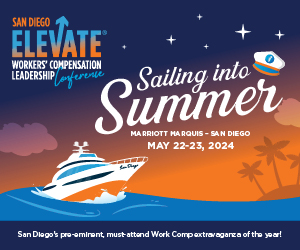Thompson: Claimant "Apps" and the "Internet of Comp-Things"
Monday, March 14, 2016 | 1
While “smart” technology deliberately surges to attach and change every known part of our greater human experience, the work comp claims world is timidly fumbling with concepts for “stupid” claimant apps. So far, no breakthrough product is on the verge.
The oh-so delicate balance yet to be reached in marketing a useful claimant app is challenged by critical factors:
– The need to make something appear useful for claimants while actually seeking to make something that will reduce time requirements of adjusters.
– Avoiding the legal appearance of any information on the user’s app constituting compensability or obviating any statutory formality in defining the claim parameters.
– The fear of including any prospective information regarding comp-rate or payment approvals, medical procedures, or expected disability days as it may constitute some promise and create new legal causes of action.
– The unwillingness to create an actual communication channel as part of an app for fear of discoverability and due to the likely counter-intuitive increased need for adjusters to be responsive.
In essence, any “smart” claimant apps we are beginning to see do nothing more than confirm innocuous information (claim number, last check paid, last doctor’s appointment) while providing another method of thwarting claimant outreach that will rival good old voicemail. I can predict that the standard claim office outgoing phone message will direct any claimant callers to first check their app before trying to call their adjuster.
Quick Tip: Let’s Dare To Get As Smart As Possible
If the industry has any real guts, then heed my challenge: Smart technology should be fully harnessed, legislatively blessed and activated as the main claim engine. It should also keep a tighter rein on claimants than the natural world has yet to allow. Here are some technologically valid ideas that are but a standard development process and legislative vote away:
1) Every new claimant is issued a legally mandatory “wearable” connected to a mandatory smart-phone app.
2) The wearable senses and saves claimant activity levels while the wearable’s GPS saves knowledge of claimant whereabouts. This can be unlocked when litigation discovery might allow.
3) Wearable can provide real-time drug/alcohol/substance check in claimant’s system.
4) Medical appointment scheduling and calendar function is tied to UR and approval process, all calendar appointments are approved in real time to claimant and provider or will not be scheduled.
5) One-click pre-paid ride services are available if transportation to an approved appointment is necessary.
6) Physician EMR is absorbed in the app. Medical information is compiled in the app and programs and/or internal referral to a consulting peer physician calculate and align diagnosis with disability projections, referrals, diagnostic needs, and milestone medical follow up dates. This sets expectations for resolution with both the claimant and doctor.
7) Phone app allows real time payment transaction at point of provider service, bill repricing technology and network adjustments are done by the app in real time. Maybe Apple will own the repricing process as part of “Apple Pay”, and make their fees from bank interchange. No more “managed care” charges to the claim. TPA repricing services no longer exist.
8) All benefit payments are transacted via the app directly into a designated claimant bank account, or a specially created Pay-Pal account for non-bank claimants. Checks are obsolete.
9) At the time of MMI, claimants who are in resolution or settlement situations can check “similar payout” ranges for unrepresented claims of similar parameters. The App can make a programmed offer. The claimant can accept and have immediate money in their personal account, or be bounced out to the “old fashioned” method of litigating and/or mediating settlements.
10) Claimants straying from projected medical milestone improvements or surpassing disability days will trigger an employer request for legal review and possible “warrant” for the wearable to release claimant activity, location, substance information, etc. in order to check validity of claimant’s position.
11) Surveillance can be targeted using GPS locations that correlate with increased body stresses, alcohol or drug use, questionable locations (Gym, Casino, Commercial Job Site, etc.) or other suspicions.
12) Litigation discovery can include a date-mapping of claimant locations, activity ranges (body stress indicators) or substances in the blood, etc. Valid evidence includes anything saved from the wearable that might indicate highly functional activities, other traumatic incidents, co-morbidities, idiopathic problems, and/or other questionable aspects.
Should employers be allowed such tight control? I say that if a claimant is 100% above-board, this technology is a net positive to enhance their experience. Certainly, this concept is much better than the current flimsy emerging offerings that constitute claimant apps. Let’s forget how safe we want to be and focus on how creative we can get!
Barry Thompson is a renowned Risk Management Consultant with roots in a 1982 claim adjusting desk and branches bearing the fruit of a career-focus on improving Workers’ Compensation. He is Founder and President of Risk Acuity, LLC as well as creator and operator of ClaimAnswer.com. He began publication of his blog, Quick Tips, in 2004. Each edition brings a unique independent employer-focused source of Workers’ Comp advice, information and ideas.




Comments